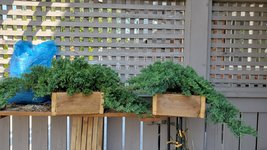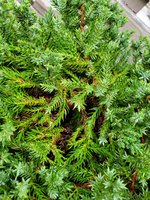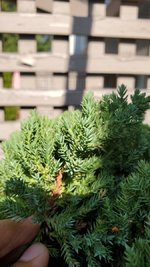Bad_Bonsai
Sapling
Hello,
My wife has given me the go-ahead to change up the front lawn this spring, So I now have two sizable Juniper to work with and I'm really excited. They were on opposite sides of our south-facing home and show slightly different growth patterns. The one on the easternmost side grew kind of longer and lankier (not in an unhealthy manner) but the one on the west, grew really, really dense foliage. All to say, I think I have two different but really great pieces of material to work with.
What I'm questioning is, how exactly should I go about the collection. Should I reduce the root ball, or should I attempt to detangle the roots to preserve as much as possible?
Is this the right time of year? I'm in Ottawa, Canada. Weather shows lows of 5*C in the forecast going forward - The highs go into the high teens, so I'm not concerned about frost.
I'm not completely lost in the ozone on this. I know I shouldn't bare-root it, and I have my additives selected; Hyuga Pumice, Vermiculite, Garden soil with perlite.
But I have some other trees I threw into straight pumice and they're still looking great.
EDIT: I'd be looking to move these two junipers into Wooden Crates I'd build. I don't think I have pots suitable for these yet. In the crates, they would remain for the year, mostly untouched and out of direct sunlight.
What are your experiences with collecting lawn junipers?
My wife has given me the go-ahead to change up the front lawn this spring, So I now have two sizable Juniper to work with and I'm really excited. They were on opposite sides of our south-facing home and show slightly different growth patterns. The one on the easternmost side grew kind of longer and lankier (not in an unhealthy manner) but the one on the west, grew really, really dense foliage. All to say, I think I have two different but really great pieces of material to work with.
What I'm questioning is, how exactly should I go about the collection. Should I reduce the root ball, or should I attempt to detangle the roots to preserve as much as possible?
Is this the right time of year? I'm in Ottawa, Canada. Weather shows lows of 5*C in the forecast going forward - The highs go into the high teens, so I'm not concerned about frost.
I'm not completely lost in the ozone on this. I know I shouldn't bare-root it, and I have my additives selected; Hyuga Pumice, Vermiculite, Garden soil with perlite.
But I have some other trees I threw into straight pumice and they're still looking great.
EDIT: I'd be looking to move these two junipers into Wooden Crates I'd build. I don't think I have pots suitable for these yet. In the crates, they would remain for the year, mostly untouched and out of direct sunlight.
What are your experiences with collecting lawn junipers?
Last edited:








